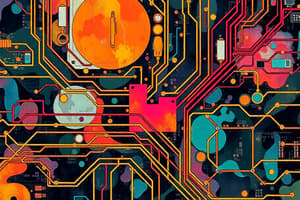Podcast
Questions and Answers
What is the purpose of the ioctl() system call in Linux?
What is the purpose of the ioctl() system call in Linux?
- To close open files
- To change hardware settings (correct)
- To create new files
- To read data from a file
The 'with' statement in Python does not automatically close the file after reading or writing.
The 'with' statement in Python does not automatically close the file after reading or writing.
False (B)
What command is used in Windows to retrieve details about volumes?
What command is used in Windows to retrieve details about volumes?
Get-Volume
The device file /dev/null in Linux is used to _______ any data written to it.
The device file /dev/null in Linux is used to _______ any data written to it.
Match the following I/O commands with their descriptions:
Match the following I/O commands with their descriptions:
What function does a device driver perform in the context of I/O system calls?
What function does a device driver perform in the context of I/O system calls?
Virtual devices are treated differently by the operating system compared to physical devices.
Virtual devices are treated differently by the operating system compared to physical devices.
Name two common system calls used for file I/O operations.
Name two common system calls used for file I/O operations.
In cloud computing environments, virtual devices like virtual disks are managed through ____ operations.
In cloud computing environments, virtual devices like virtual disks are managed through ____ operations.
Match the following I/O commands with their appropriate operating systems:
Match the following I/O commands with their appropriate operating systems:
Which of the following is a typical application of I/O operations?
Which of the following is a typical application of I/O operations?
I/O operations are unimportant in embedded systems and IoT devices.
I/O operations are unimportant in embedded systems and IoT devices.
What is the role of a hypervisor in managing virtual devices?
What is the role of a hypervisor in managing virtual devices?
Which command is used in Linux to unmount a file system?
Which command is used in Linux to unmount a file system?
The fdisk -l command in Linux displays currently mounted file systems.
The fdisk -l command in Linux displays currently mounted file systems.
What does a TCP server socket do upon a client connection?
What does a TCP server socket do upon a client connection?
Windows uses the __________ model for driver standardization.
Windows uses the __________ model for driver standardization.
Which of the following I/O characteristics is true for Linux?
Which of the following I/O characteristics is true for Linux?
Match each operating system with its I/O characteristics:
Match each operating system with its I/O characteristics:
Android operates with a Hardware Abstraction Layer (HAL).
Android operates with a Hardware Abstraction Layer (HAL).
What is the purpose of I/O system calls?
What is the purpose of I/O system calls?
Flashcards
I/O System Calls
I/O System Calls
Functions that allow software to interact with hardware or virtual devices.
lsblk Command (Linux)
lsblk Command (Linux)
A Linux command that lists information about block devices, such as hard drives and partitions.
fdisk -l Command (Linux)
fdisk -l Command (Linux)
A Linux command displaying partition tables of available disks.
mount Command (Linux)
mount Command (Linux)
Signup and view all the flashcards
umount Command (Linux)
umount Command (Linux)
Signup and view all the flashcards
Windows Driver Model (WDM)
Windows Driver Model (WDM)
Signup and view all the flashcards
Device Manager (Windows)
Device Manager (Windows)
Signup and view all the flashcards
I/O Request Packets (IRPs)
I/O Request Packets (IRPs)
Signup and view all the flashcards
Device Driver
Device Driver
Signup and view all the flashcards
Virtual Device
Virtual Device
Signup and view all the flashcards
Hypervisor
Hypervisor
Signup and view all the flashcards
System Call (I/O)
System Call (I/O)
Signup and view all the flashcards
Device Abstraction
Device Abstraction
Signup and view all the flashcards
File I/O
File I/O
Signup and view all the flashcards
Database Management
Database Management
Signup and view all the flashcards
Real-world application of I/O
Real-world application of I/O
Signup and view all the flashcards
File I/O Operations
File I/O Operations
Signup and view all the flashcards
Device File in Linux
Device File in Linux
Signup and view all the flashcards
What is ioctl()?
What is ioctl()?
Signup and view all the flashcards
Using ioctl() in Python
Using ioctl() in Python
Signup and view all the flashcards
Windows Disk Management
Windows Disk Management
Signup and view all the flashcards
Study Notes
Input/Output Management
- Input/Output (I/O) Management is crucial in operating systems, bridging the gap between software and hardware.
- It manages data transfer between the computer and external devices (disks, keyboards, printers).
- The operating system (OS) controls data flow to ensure efficiency and error-free operations.
- Without I/O management, applications would directly handle hardware communication, making it complex and inconsistent.
Key Components of I/O Management
- I/O Devices: Physical components (keyboards, printers, storage drives) that interact with the computer.
- Buffers: Temporary storage areas for data transfer to manage speed differences between devices and software.
- Device Drivers: Specialized programs that allow the OS to communicate with specific hardware devices.
Examples of I/O Components
- I/O Devices: Keyboard, Printer, Storage Drives (SSDs, HDDs, USB drives), Monitor, Network Card.
- Buffers: Print Buffer, Keyboard Buffer, Network Buffer, Monitor Buffer, Disk Cache
- Device Drivers: Graphics Driver, Printer Driver, Network Adapter Driver, Sound Card Driver, USB Controller Driver
Objectives of I/O Management in OS
- Enable smooth data transfer between software and hardware.
- Improve overall system performance by efficiently handling device requests.
- Ensure security and error handling during data transfers.
System Calls in I/O Management
- System calls provide commands for applications to perform basic file and device operations (e.g. open(), read(), write(), close()).
- open(): Opens a file or device for reading or writing.
- read(), write(): Transfers data to/from a file or device.
- close(): Closes the connection to a file or device when done.
- System calls act as a bridge between user applications and hardware, controlling access and security.
- ioctl(): An advanced Linux system call allows device-specific commands for interacting with hardware.
File I/O Operations (Python)
- File I/O operations in Python use the
open()function for reading and writing files. - For writing, mode 'w' and
write()are used. - For reading, mode 'r' and
read()are used. - The
withstatement automatically closes the file after operations.
Interacting with Device Files on Linux
- In Linux, device files represent system resources.
- The
/dev/nulldevice file discards any data written to it.
Device I/O Using ioctl() on Linux
- The
ioctl()system call is used for device-specific operations (controlling hardware). fcntl.ioctl()is used in Python to interact with device files.os.open()opens device files,fcntl.ioctl()sends control commands, andos.close()closes the file descriptor.
I/O System Calls on Different Operating Systems (Windows Commands)
- diskpart: Opens the DiskPart command-line tool for managing disk partitions.
- Get-Volume: A PowerShell command to retrieve details about volumes (filesystem type, size, label).
I/O System Calls on Different Operating Systems (Linux Commands)
- Isblk: Lists information about block devices (hard drives, partitions).
- fdisk -l: Displays partition tables of all available disks.
- mount: Shows currently mounted file systems.
- umount: Unmounts a file system.
Interacting with Network Devices
- TCP server (server.py) and client (client.py) code for sending and receiving messages.
- The server establishes a socket and binds to a port, then listens for connections.
- Clients connect to the server on the specified port.
I/O in Different Operating Systems
- Windows: Uses the Windows Driver Model (WDM) for driver standardization, Device Manager, Plug and Play (PnP), and I/O Request Packets (IRPs).
- Linux: Employs kernel and user space separation, treats devices as files in
/dev, supports modular drivers (loadable without reboot), and uses the Virtual File System (VFS). - macOS: Utilizes I/O Kit for device abstraction, plug-and-play, and leverages its UNIX-based architecture.
- Android: Based on a modified Linux kernel with a Hardware Abstraction Layer (HAL) for broad hardware support and Binder IPC.
- UNIX: Treats devices as files in
/dev, supports I/O redirection, and adheres to POSIX standards.
How I/O System Calls Interact with Hardware/Virtual Devices
- I/O system calls act as intermediaries between software applications and hardware/virtual devices.
- When a program requests I/O, the system call sends the request to the operating system.
- For physical devices, the OS communicates with device drivers, then converts software requests into hardware-specific instructions.
- For virtual devices, the OS treats them like physical devices but routes requests through software layers (like hypervisors or virtual machine managers).
Real-World Applications of Device and File I/O Operations
- Operating systems use file I/O for managing user data.
- Database systems use file I/O to efficiently store and retrieve data.
- Web servers use file I/O to serve static content.
- Embedded systems use device I/O for hardware communication (sensors, actuators).
- Networking relies on I/O operations for sending and receiving data packets.
- Cloud computing utilizes I/O for simulating physical resources across virtual machines.
Key Takeaway
- System calls enable applications to interact with files and devices, simplifying hardware communication.
- Device abstraction provides a consistent interface for interacting with hardware/virtual devices, hiding complexities.
- I/O operations are crucial for many real-world applications.
Studying That Suits You
Use AI to generate personalized quizzes and flashcards to suit your learning preferences.




